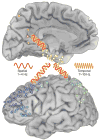Intracranial recordings and human memory
- PMID: 25113154
- PMCID: PMC4326634
- DOI: 10.1016/j.conb.2014.07.021
Intracranial recordings and human memory
Abstract
Recent work involving intracranial recording during human memory performance provides superb spatiotemporal resolution on mnemonic processes. These data demonstrate that the cortical regions identified in neuroimaging studies of memory fall into temporally distinct networks and the hippocampal theta activity reported in animal memory literature also plays a central role in human memory. Memory is linked to activity at multiple interacting frequencies, ranging from 1 to 500Hz. High-frequency responses and coupling between different frequencies suggest that frontal cortex activity is critical to human memory processes, as well as a potential key role for the thalamus in neocortical oscillations. Future research will inform unresolved questions in the neuroscience of human memory and guide creation of stimulation protocols to facilitate function in the damaged brain.
Copyright © 2014 Elsevier Ltd. All rights reserved.
Figures


References
-
- Goldman-Rakic P. Cellular basis of working memory. Neuron. 1995;14:477–485. - PubMed
-
- Müller NG, Knight RT. The functional neuroanatomy of working memory: Contributions of human brain lesion studies. Neuroscience. 2006;139:51–58. - PubMed
-
- Burke JF, Long NM, Zaghloul KA, Sharan AD, Sperling MR, Kahana MJ. Human intracranial high-frequency activity maps episodic memory formation in space and time. NeuroImage. 2014;85:834–843. Using subdural and depth recordings in a cohort of 98 patients, the authors report that the neural regions identified in functional magnetic resonance imaging (fMRI) as associated with successful encoding fall into two spatiotemporally distinct neural networks – likely reflecting bottom-up perceptual processing and top-down control, respectively. This large-scale study demonstrates how intracranial recordings expand on traditional highspatial resolution imaging methods available to study human memory. - PMC - PubMed
Publication types
MeSH terms
Grants and funding
LinkOut - more resources
Full Text Sources
Other Literature Sources
Medical

